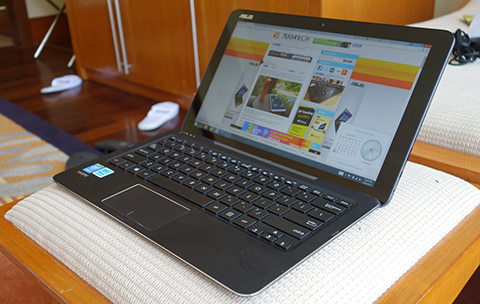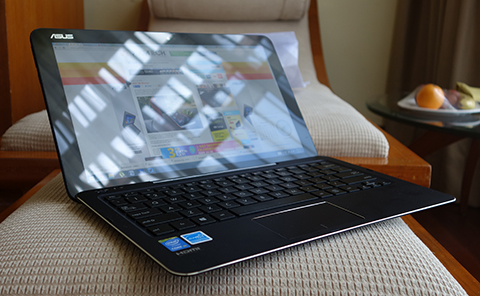Asus has been making really well-crafted laptops and ultrabooks since they introduced the Zenbook and the Transformer line of devices. The Transformer Book T300 Chi is the latest innovative product that attempts to blur the line between a full-sized tablet and productivity laptop. Check out the full review below to find out why.
The Transformer Book Chi is not the first of its kind. Asus has made a lot of various iterations of a hybrid tablet or 2-in-1 laptop going as far back as the Transformer Pad, the Transformer Book Trio, and the very popular Transformer Book T100.

In a sense, the Transformer Book T300 Chi is a move to make an ultrabook version of the Transformer Book T100. That’s pretty evident from the SSD storage, Core M processor, hefty servings of RAM packed in a premium, thin and light body.
Design.
At first glance, the T300 Chi looks like a typical laptop or ultrabook crafted in a full metal body with very slim and sleek design. It resembles the venerable Zenbook line of laptops popularized by Asus also it also shared the same genetic codes as the Transformer Pad.
The screen is detachable from the keyboard dock and works stand-alone as a Windows 8 tablet which is somewhat huge for a tablet but still comfortable enough to hold and use as a daily driver. Because of the slim profile, all the ports around the tablet are miniaturized — a microSD card slot at the bottom end; a micro-HDMI, micro USB 3.0, and 3.5mm audio port ont he right side, power button on top, volume controls and Windows button on the left along with a micro-charging port.

The keyboard dock connects to the tablet via two metal latches that locks it in place and lined up with a magnetic lining to help keep it more stable. Communication between the keyboard and the tablet is only via Bluetooth which will allow you to use the keyboard regardless if the tablet is docked or not.
There’s a Bluetooth switch on the keyboard so you can manually turn off the connection in order to conserve battery on the dock. The dock does not add any battery support to the tablet but has its own small reserved battery to power the Bluetooth connection (which you can recharge via a micro-USB port).

The combined weight of the T300 Chi is 3.13 lbs which makes it sound heavier than many ultrabooks we’ve seen around. The 11.6-inch Macbook Air is 2.38lbs while the 13.3-inch model is still lighter at 2.96bs. Compared to the 13-inch Zenbook Prime which is just 2.86lbs and the 11-inch model UX21 which is just 2.4lbs, the T300 Chi is still much heavier.
However, if you compare the tablet alone (1.56lbs) to the Surface Pro 3 (1.76lbs), you will realize that the T300 Chi is still lighter which brings us to the conclusion that the Keyboard dock significantly added to the bulk weight of the setup. When docked, the display wobbles a bit on its place which can be disconcerting at times.
Display.
Asus also introduced a 12.5-inch display with the T300 Chi, a conservative size between the traditional 11.6-inch and 13.3-inch which they could have found to be the sweet spot for this form factor. With a full HD IPS LCD, the display looks bright and stunning (Asus is not releasing the WQHD version in the Philippines).

A full HD resolution (1920×1080 pixels) is actually more than enough pixels for a screen size of only 12.5 inches. The bezels are a bit thick though but we think Asus did it that way to allow enough space on the sides when you’re holding the tablet with both hands.
The touchscreen is responsive and accurate although we really seldom use it. The only useful instance we really appreciate the touchscreen input is when the Bluetooth keyboard takes a while to reconnect to the tablet after sleep mode.

We also discovered that you can also slide the tablet on its back so you can have those modes that we originally saw with the Lenovo Yoga (tent mode, easel mode).
Operating System.
Nothing much can be said of the operating system except perhaps the fact that Windows 8.1 still needs a bit of polishing in terms of navigation and usability in the tablet mode. Once all updates and drivers were downloaded and installed, everything worked just fine.

We did not encounter any problems or hiccups although there was one occasion that the device did not automatically go to sleep mode after closing the lid (so it has been a practice to manually put it in sleep mode before stowing it inside the bag).
For the most part, we don’t really use the Windows 8 mode as we seldom use the tablet on its own (except for casual reading in the bedroom).
Performance.
The big promise for a balanced performance and battery life is committed by the Intel Core M processor. The 5Y71 uses the latest 14nm process and runs at a base clock of 1.2GHz (dual-core, 4 threads) but can boost to speeds up to 2.9GHz. It has a low-power consumption of just 4.5W which is much lower compared to a 5th-gen Intel i3-5020U at 15W but with comparable performance. This means you will get your required power when you need it yet still be able to reduce power consumption.

Based on our usual productivity workload, the Core M feels closer to the Core i3 rather than a Core i5. It’s fast when you needed it to be and the core can Turbo Boost up to 2.9GHz but there are times that you’ll feels it chokes on the multi-threading tasks.
Battery Life.
With the promised 8 hours battery life, we were expecting somewhere close to that in our actual use. Certainly enough, we managed to hit around 8.5 hours on a full charge but that’s with ultra power saving mode (no WiFi, 20% brightness and mostly office productivity like MS Word and Excel).
On moderate use (with the WiFi on, working on multiple Chrome tabs, photo re-sizing on Adobe Photoshop), battery life drops to a disappointing 4 to 4.5 hours. Crank it up to Performance Mode and just playing DoTA, we saw around 2.5 to 3 hours game time.

With this battery performance, we’re not really seeing any significant difference compared to other ultrabooks running Intel Core i5 or i7 processors. Perhaps, this performance is due to the fact that Asus had to cram Li-Po batteries into a much smaller space on the tablet.
Compared to regular ultrabooks that pack a 3-cell battery, the T300 Chi only has a 2-cell battery. This is the single biggest reason why we’re getting average battery life. Had Asus tried to put a 3-cell battery in here, we’d be seeing impressive battery life.
As for the keyboard dock, it took us more than 3 weeks for the built-in Li-Ion battery to drain to 10% which is pretty efficient. We just plugged it into a microUSB for a couple of hours and we’re off to full charge again.
Conclusion.
The Transformer Book T300 Chi supposedly offers a really good concept — thinner and lighter than your typical ultrabook, comparable performance to a Core i3 or Core i5 with much better battery life than the 5-7 hours most 2014 ultrabooks promised, all cooked up in a very elegant and beautiful body.
There’s a downside to a thinner form factor. The miniaturized ports require you to bring along several adaptors for the microUSB (to USB Type A) and the HDMI. This means you also need a USB hub if you want to plug several USB devices to the laptop at the same time.

In hindsight, the T300 Chi may need some polishing in a few places. Asus may need to work the gross weight to put at par with most ultrabooks in the market and perhaps push for much better battery life (a 3-cell battery will suffice).
All things considered, we are looking at the Transformer Book T300 Chi as a direct competitor to the Surface Pro 3 but with a form factor that’s much closer to ultrabooks, like the Zenbook. It’s a really nice idea, a concept that offers something more than your typical laptop or tablet, but it’s a pretty hard trick to perfectly execute. Asus is on the right track and this first iteration of the Chi is already a looker and a great first try. We think Asus can do much better on the second generation.
The Transformer Book T300 Chi was launched in the Philippines last April 7 with a suggested retail price of Php39,995 for the 4GB model and Php46,995 for the 8GB model. The unit that we bought and reviewed runs on a Core M 5Y71 with 8GB RAM.
ASUS Transformer Book T300 Chi specs:
12.5-inch fHD IPS LCD @ 1920×1080 pixels
Intel Core M 5Y71 processor, up to 2.90 GHz
Intel HD Graphics 5300
8GB LPDDR3 RAM
128GB SSD
WiFi 802.11ac
Bluetooth 4.0
HD Web Camera
1 x COMBO audio jack
2 x micro USB
1 x micro HDMI
1 x Bluetooth On/Off Switch
1 x SD card reader
1X AC adapter plug
Built-in Speakers And Array Microphone
SonicMaster Audio
32 Whrs battery
Windows 8.1
317.8 x 191.6 x 7.6 ~ 16.5 mm
720g (tablet)
1.43kg (gross weight)
What we liked about it:
* Impressive design and build
* Generous RAM allowance
* Great display
* Nice keyboard dock
* Slim and light tablet
What we did not like:
* Average battery life
* Wobbly display cradle
* No backlit keyboard
* Small trackpad
* Tablet and keyboard combo a bit heavy

YugaTech.com is the largest and longest-running technology site in the Philippines. Originally established in October 2002, the site was transformed into a full-fledged technology platform in 2005.
How to transfer, withdraw money from PayPal to GCash
Prices of Starlink satellite in the Philippines
Install Google GBox to Huawei smartphones
Pag-IBIG MP2 online application
How to check PhilHealth contributions online
How to find your SIM card serial number
Globe, PLDT, Converge, Sky: Unli fiber internet plans compared
10 biggest games in the Google Play Store
LTO periodic medical exam for 10-year licenses
Netflix codes to unlock hidden TV shows, movies
Apple, Asus, Cherry Mobile, Huawei, LG, Nokia, Oppo, Samsung, Sony, Vivo, Xiaomi, Lenovo, Infinix Mobile, Pocophone, Honor, iPhone, OnePlus, Tecno, Realme, HTC, Gionee, Kata, IQ00, Redmi, Razer, CloudFone, Motorola, Panasonic, TCL, Wiko
Best Android smartphones between PHP 20,000 - 25,000
Smartphones under PHP 10,000 in the Philippines
Smartphones under PHP 12K Philippines
Best smartphones for kids under PHP 7,000
Smartphones under PHP 15,000 in the Philippines
Best Android smartphones between PHP 15,000 - 20,000
Smartphones under PHP 20,000 in the Philippines
Most affordable 5G phones in the Philippines under PHP 20K
5G smartphones in the Philippines under PHP 16K
Smartphone pricelist Philippines 2024
Smartphone pricelist Philippines 2023
Smartphone pricelist Philippines 2022
Smartphone pricelist Philippines 2021
Smartphone pricelist Philippines 2020
klky says:
dati takang taka ako kung bakit napaka lag ng site ng yugatech… ngaun alam ko na..
dami palang script na nakakalat sa site na to, ngaun gumamit ako ng noscript sa firefox at viola! nwla ang lag ang bilis pa ng browsing
Jay says:
I could live with the thick bezels but the disappointing battery life is unfortunate. Medyo affordable pa naman sana. There also seems to be significant “air gap” in the display.
meh says:
No full sized ports especially usb ports.
Below average battery life.
Pricey
Meh
Just add 3k, you can get 11inch Macbook Air, 5th gen Intel core i5 :v
Longer battery life same ssd